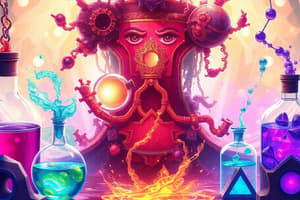Podcast
Questions and Answers
What is an element?
What is an element?
A substance that cannot be separated or broken down into simpler substances by chemical means; all atoms of an element have the same atomic number.
What is a compound?
What is a compound?
A substance made up of atoms of two or more different elements joined by chemical bonds.
What constitutes a mixture?
What constitutes a mixture?
A combination of two or more substances that are not chemically combined.
Define an atom.
Define an atom.
What is a molecule?
What is a molecule?
What is a heterogenous mixture?
What is a heterogenous mixture?
Describe a homogeneous mixture.
Describe a homogeneous mixture.
What is a pure substance?
What is a pure substance?
What is matter?
What is matter?
What are the two types of matter?
What are the two types of matter?
How do mixtures differ from compounds?
How do mixtures differ from compounds?
What defines a compound?
What defines a compound?
Give examples of properties of compounds.
Give examples of properties of compounds.
What are the properties of a homogeneous mixture?
What are the properties of a homogeneous mixture?
What are the characteristics of a heterogeneous mixture?
What are the characteristics of a heterogeneous mixture?
What is CH4?
What is CH4?
What is S8?
What is S8?
What is distilled water classified as?
What is distilled water classified as?
What is salt water?
What is salt water?
Define CH2O.
Define CH2O.
What is concrete classified as?
What is concrete classified as?
What is C+O2 classified as?
What is C+O2 classified as?
What is CO?
What is CO?
What is CO2?
What is CO2?
What does Co represent?
What does Co represent?
Flashcards are hidden until you start studying
Study Notes
Classifications of Matter
-
Element: A fundamental substance that cannot be chemically separated into simpler forms. All atoms share the same atomic number.
-
Compound: A substance formed from two or more different elements chemically bonded together.
-
Mixture: A combination of multiple substances that are not chemically bonded, allowing for the separation of components.
-
Atom: The smallest unit of an element that retains the element's characteristics.
-
Molecule: The smallest unit of a substance that preserves all the physical and chemical properties of that substance.
Mixtures
-
Heterogeneous Mixture: A mixture with uneven distribution of components, not uniformly mixed.
-
Homogeneous Mixture: A mixture that appears uniform in composition throughout.
Pure Substances and Types of Matter
-
Pure Substances: Composed of a single type of particle.
-
Two Types of Matter:
- Pure Substances: Includes elements and compounds.
- Mixtures: Categorized into homogeneous and heterogeneous mixtures.
-
Mixtures: Composed of two or more components physically mixed, maintaining the original properties of the substances.
Elements and Compounds
-
Elements: Consist of only one type of atom; cannot be simplified by chemical reactions.
-
Properties of Elements: Include both chemical and physical characteristics; examples include Calcium, Copper, Gold, and Nitrogen.
-
Compounds: Combinations of two or more different elements that are chemically combined.
-
Properties of Compounds: Include unique characteristics derived from the elements that make them up; examples include Hydrogen Peroxide, Salt, Alcohol, and Glucose.
Properties of Mixtures
-
Homogeneous Mixture Properties:
- Consists of one phase
- Uniform throughout
- May form a solution
- Examples: Iced Tea, Stainless Steel, Maple Syrup, Brewed Coffee.
-
Heterogeneous Mixture Properties:
- Exhibits uneven composition
- Examples: Orange juice with pulp, Chocolate Chip Cookies, Sandy Water, Chicken Noodle Soup.
Specific Examples
-
CH4 (Methane): Classified as a compound.
-
S8: An example of an element.
-
Distilled Water: Considered a compound comprised of H2O.
-
Salt Water: Defined as a homogeneous mixture due to uniform salt distribution.
-
C + O2: Represents a heterogeneous mixture.
-
CO (Carbon Monoxide): A compound formed from Carbon and Oxygen.
-
CO2 (Carbon Dioxide): Another compound made from the elements Carbon and Oxygen.
-
Co: An element, as indicated by a single capital letter.
Summary of Matter Classification
- Matter is categorized into two main classifications: Pure substances (elements and compounds) and mixtures (homogeneous and heterogeneous). Understanding these basic definitions and properties is crucial for studying chemistry.
Studying That Suits You
Use AI to generate personalized quizzes and flashcards to suit your learning preferences.




